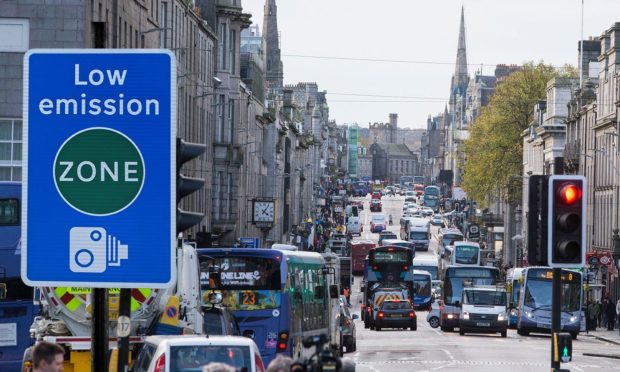Aberdeen’s low emission zone (LEZ) has been formally introduced as of May 31, 2022.
Once fully enforced, anyone who takes a vehicle into the area which does not meet strict emissions criteria could face a fine.
Here’s everything you need to know about Aberdeen’s LEZ.
Why is this happening?
In September 2017, the Scottish Government committed to the introduction of LEZs in Scotland’s four biggest cities, Glasgow, Edinburgh, Aberdeen and Dundee by 2020, in order to improve air quality.
However, due to the impact of the pandemic and lockdowns, this date was pushed back.
When will enforcement start and how will it work?
The council will allow for a two-year grace period from the introduction of the project on May 31, 2022, during which no enforcement will take place.
This means that no fines will be issued until 2024.
The council estimates that by 2024, 86% of cars, 70% of light goods vehicles such as vans, and 93% of heavy goods vehicles and all taxis in Aberdeen will meet the requirements of the LEZ.
Enforcement will be carried out using automatic number plate (ANPR) cameras. It is not yet known how many will be put in place across the LEZ.
How much will the fines be?
The initial penalty charge for banned vehicles caught within the zone once enforcement commences will be £60, but reduced to £30 if paid within 14 days.
This penalty would double with each subsequent breach of LEZ rules, and is capped at £480 for cars and light goods vehicles, and £960 for buses and HGVs.
Are there exemptions, such as for classic cars?
There are a number of exemptions, such as for all emergency vehicles, as well as any naval, military or air force vehicles.
The rules also allow for “historic vehicles”, and vehicles being used by anyone who is disabled.
Another exemption has been made for “showman vehicles”, which are “highly specialised vehicles used for the purposes of travelling showmen, where the vehicle is used during the performance”.
Where exactly is it in Aberdeen?
It covers the majority of Aberdeen City Centre, and also incorporate parts of areas like Ferryhill and the West End.
The initial boundaries of the LEZ were been re-drawn in November 2021 following feedback from the public, and it is smaller than what was first put forward.
The initial plans included the East North Street, Commerce Street and Wapping Street areas.
But on the new map of the LEZ which was implemented on May 31, the boundaries in these areas have been scaled back.
Will there be any financial help available for owners of banned vehicles?
Yes, across Scotland millions of pounds worth of funding has been made available for those “who will have the most difficulty preparing for the introduction of LEZs”.
Grants are available to support the cost of retrofitting engines or exhausts on taxis, vans, and heavy goods vehicles.
Households can also apply for cash grants to “incentivise disposal of a non-LEZ compliant vehicle”.
You can find out more about household grants here.
What benefits could the LEZ bring, and how bad is the pollution problem?
In an emissions analysis report, the Scottish Environment Protection Agency said introducing an LEZ, in combination with the city centre masterplan, could reduce harmful emissions on Union Street by 29%.
Poor air quality contributes to a number of concerns aside from harming the environment.
Air pollution can have a more severe impact on the young, pensioners, and those with chronic heart and lung conditions.
Although the council says there has been an increase in air quality in the city centre since the opening of the Aberdeen Bypass, many of the air monitoring stations in the city centre still regularly exceed or come close to exceeding accepted levels of nitrogen dioxide.
Most of these sites are along very busy roads.
The council hopes the LEZ will make Aberdeen and the city centre “safe, desirable and welcoming environments for living, working, shopping and leisure”, and anticipates the “LEZ will support economic recovery and city centre regeneration as we emerge from the Covid-19 pandemic.”
Will my vehicle be banned?
Generally, older vehicles that do not meet emission requirements will not be allowed into Aberdeen’s LEZ once enforcement starts.
These include diesel cars and vans registered before 2015 which generally do not meet Euro 6 standards, and petrol vehicles registered before 2006.
Heavy goods vehicles, coaches and buses registered from 2013 onwards will generally be permitted, and all motorcycles and mopeds will be free to enter the LEZ.
Electric vehicles will also be exempt.
If you would like to tell us what you think about the LEZ, let us know in the comments below.

Conversation